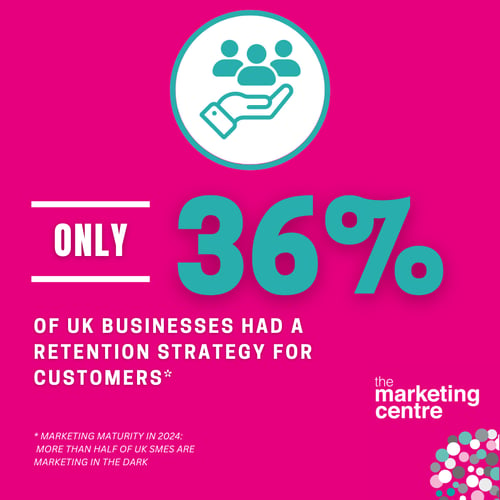In a growth-driven world, businesses often focus on the new: new markets, clients, products or services. Too often they miss our most reliable source of profit – existing customers. The probability of selling to an existing customer is somewhere between 60% and 70% compared to between 5% and 20% for successfully selling to a new prospect. They’re also cheaper to market to, it costs three times as much to win a new customer as it does to retain an old one.
Existing customers have already bought into your offering and your marketing. You know something about them – what they bought, at the very least, and ideally why they bought it. They’re an easier proposition than someone who needs to be made aware, warmed up and converted from scratch.
That’s why customer retention is such an important element of marketing theory. So, what do you need to know?
What SMEs need to know about customer satisfaction?
Small businesses have an innate upper hand when it comes to customer retention. Customers and clients generally experience a more personal service when there’s a smaller team serving them. Over on the High Street, 84% of Britons rate the personal touch of independent shops as average to very good – and there’s no reason to believe this doesn’t carry over to B2B.
However, there are challenges to delivering a personal service. Customers with complaints increasingly expect to speak to a senior figure and expect a swifter response. Delivering this kind of personal service is easy enough when you start out. As organisations grow, though, it’s easy to lose connections made.
B2B Customer Satisfaction vs B2C
While B2C customer relations are often based on transactions, B2B is usually a much longer play – an agreement that often naturally lends itself to forming a long-standing relationship between the parties involved. Large businesses can often court a prospect for months, sometimes years. In advertising, the top 40 client-agency relationships have lasted an average of 22 years, and even the industry average as a whole is a healthy 3.2 years.
B2B is about relationship building from the outset, which means retention tactics are on the cards from the start. You’re trying to ensure that every contact between you and them ends with a positive impression. If at any stage the relationship sours, though, all the previous work can be lost. Seven in ten clients are not especially committed to you or your offering, which means they’ll go elsewhere if a better offer presents itself.
B2C relationships are more direct – but it’s not all about the price, the product and the point of sale. Brand plays a huge role in customer loyalty. B2C clients need to work hard on their branding, sales processes, and customer journey to ensure that relationships continue past the point of sale. Thanking your customers, following up their purchase, and keeping yourself front-of-mind is crucial here.
What should be in your customer retention plan?
- Focus on customer experience
Foster customer loyalty by providing a seamless and satisfying customer experience. Utilise different touch points and platforms to make the experience as convenient as possible. Leverage AI and chatbots to address basic customer problems quickly, improving response times and overall satisfaction. - Regular comms.
Stay top of mind by reminding your former customers that you exist and that they did business with you. Email is particularly useful here, being less intrusive than a phone call, although calls are useful for the strategic discussions that improve B2B relationships. - Customer marketing.
Tailor messages and offers to existing customers, ideally tying into the goods or services they previously bought. Consider offering discounts on the same or similar products or recommending other offerings in the same line. - Surveys
Use surveys to justify continued contact. They're useful for identifying areas for improvement, collecting data about the customer's perceptions of value and use for the offering, and building a positive association since the company cares enough to solicit opinions. - A customer loyalty program.
Implementing a customer loyalty program can incentivise repeat purchases and foster long-term relationships. Consider offering points that customers can save and claim down the line or providing additional value-added services when they purchase a larger service package. - Contact with the human side of the business.
Building relationships and personalisation are key. Contact with the same person makes customers and clients feel cared-about. - Reporting.
Track engagement through metrics like email open and clickthrough rates, completed surveys and successful calls. - Measures of success.
These metrics constitute the bottom line, showing whether you’re succeeding in your marketing.
Metrics – how do you know you’re doing well with your customers?
The exact metrics you focus on will vary – they have to make sense for your business and your offering. For some businesses, raw retention rates – the percentage of customers who are still paying attention – will be worth focusing on. For businesses looking to improve their after-sales service, support satisfaction ratings derived from surveys will be the most important metric.
Chances are, however, you’ll be looking at one of the following:
- Customer lifetime value. Understanding how much your customers are spending and finding ways to increase that figure is crucial. For example, you can offer personalised service packages when new offerings become available, enticing customers to invest more in your products or services.
- Retention, tracked against competitors. It's essential to assess how many of your customers are sticking around compared to your competitors. If you find that your retention rates are lower, examine what your competitors are offering. Is it a flashy new deal that only applies to new customers or something that inspires customer loyalty? Armed with this information, you can communicate your value effectively to win back customers or improve your offerings to match or surpass your competitors.
- Net Promoter Score. An NPS measures the willingness of customers to recommend a company’s products or services to others. Ask for a score out of 10, Customers that give you a 6 or below are detractors, a score of 7 or 8 are called passives, and a 9 or 10 are Promoters. To calculate your Net Promoter Score, detract the percentage of detractors from the percentage of promoters.
- Client referrals. Are customers advocating for your business and driving growth in their own right?
- Conversion rates by lead source. How many of your new prospects are coming from referrals?
If you’re convinced by customer retention, but not sure where to start with your marketing, take our free Marketing 360 Assessment see how you’re currently performing.




